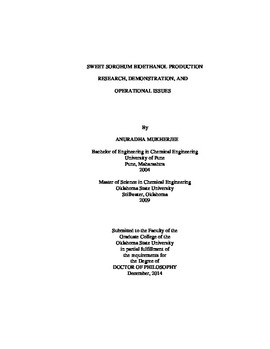| dc.contributor.advisor | Whiteley, James Robert | |
| dc.contributor.author | Mukherjee, Anuradha | |
| dc.date.accessioned | 2016-01-20T15:44:46Z | |
| dc.date.available | 2016-01-20T15:44:46Z | |
| dc.date.issued | 2014-12 | |
| dc.identifier.uri | https://hdl.handle.net/11244/25689 | |
| dc.description.abstract | Sweet sorghum or Sorghum bicolor (L) moench is sugar rich, grows with minimal inputs, and is suitable for cultivation in dry regions making it a desirable energy crop for Oklahoma. In-field fermentation of sweet sorghum reduces storage and transportation hurdles of the biofuel supply chain. For the overall success of the on-farm approach, the ethanol dewatering step is crucial. The Alcohol Separation Unit (ASU) at Oklahoma State University is a research and demonstration prototype unit, the first of its kind to study bioethanol production from fermented sweet sorghum liquid feedstock. A two-column distillation set up for concentrating ethanol from 250 gal/h liquid fermented sweet sorghum feed, with associated heat exchangers, pumps, and storage units was designed and constructed for on-farm ethanol separation. The ASU was commissioned in Fall 2013. Product ethanol (190 proof) was produced in October 2013. Ethanol purities of 193.6 proof at 74oF with rectifier column conditions of 0.8 psig and 171oF were established during processing. Overall economics of the pilot plant indicate fixed capital costs at 403,000 USD. Major unit operation equipment (columns, heat exchangers, storage tanks) makes approximately 50% of the costs. Major energy usage at the pilot plant for ethanol production is steam, which accounts for 75% of total annual operating costs of 68,000 USD. | |
| dc.description.abstract | Experiments to quantify sweet sorghum fermented juice fouling were undertaken to understand potential operational issues. Total solid loading of fermented juice was determined to be approximately 3 wt%, significantly lower compared to corn-based process streams. Heat transfer resistance (Rf) of fermented sweet sorghum was found to be approximately 9.25 x 10-5 m2 oC/W and fouling intensity is equivalent to that of tap water. Fermented sweet sorghum Rf values were found to be one tenth of corn and maize ethanol thin stillage fouling resistance. The induction period for fermented sweet sorghum fouling was more than 5 hours. With a significantly lower fouling resistance value and longer induction times for fermented sweet sorghum, fouling in equipment and the frequency of cleaning in processes is expected to be lower. Using sweet sorghum as a bioethanol crop is then advantageous over starch-based feedstocks. | |
| dc.format | application/pdf | |
| dc.language | en_US | |
| dc.rights | Copyright is held by the author who has granted the Oklahoma State University Library the non-exclusive right to share this material in its institutional repository. Contact Digital Library Services at lib-dls@okstate.edu or 405-744-9161 for the permission policy on the use, reproduction or distribution of this material. | |
| dc.title | Sweet sorghum bioethanol production: Research, demonstration, and operational issues | |
| dc.contributor.committeeMember | Ramsey, Joshua D. | |
| dc.contributor.committeeMember | Bell, Kenneth John | |
| dc.contributor.committeeMember | Bellmer, Danielle D. | |
| osu.filename | Mukherjee_okstate_0664D_13808.pdf | |
| osu.accesstype | Open Access | |
| dc.type.genre | Dissertation | |
| dc.type.material | Text | |
| thesis.degree.discipline | Chemical Engineering | |
| thesis.degree.grantor | Oklahoma State University | |
